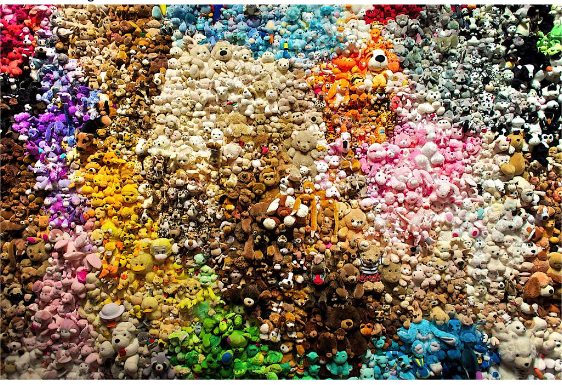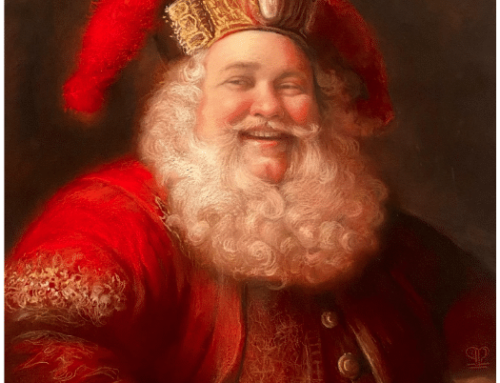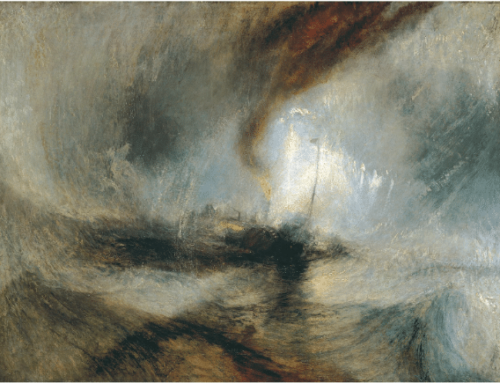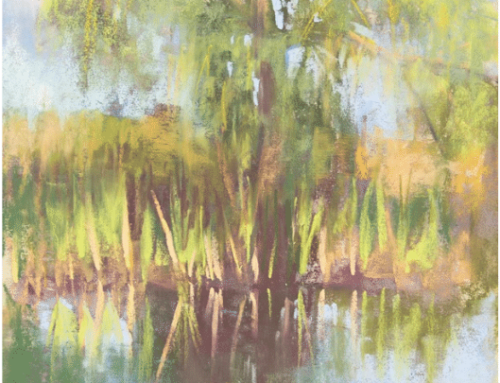Among many other accomplishments, Canadian artist Claude Cormier made “paintings” with stuffed animals. From across the room, Cormier’s massive work Stuffed Animals, installed at the Montreal Museum of Fine Art, reads like a colorful abstraction. Get closer and you realize it’s plushies – 3,000 of them, at least.
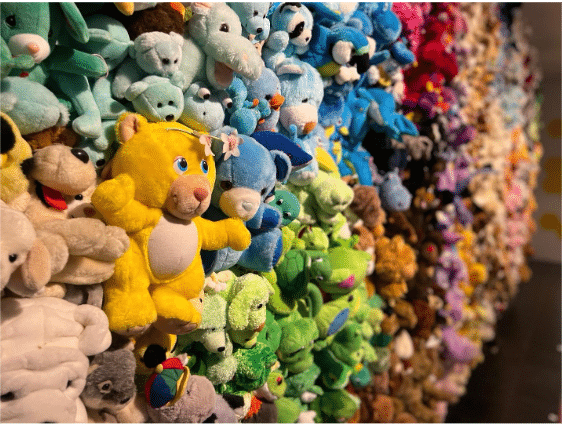
Detail, Claude Cormier, Stuffed Animals, 2012, 3,000+ stuffed animals, plywood. 8 ft. x 19 feet. Montreal Musée des beaux-arts.
Cormier, who died in 2023, originally conceived the work for the exhibition Big Bang: Creativity is Given Carte Blanche, held to commemorate the opening of a new wing in the fall of 211. For some reason the work didn’t make it into the show, but the museum has it on view and is in the process of purchasing the work for its permanent collection.
You step off an elevator and there it is, surprising and impossible to ignore, in its all its colorful, happy-to-see-you glory. Encountered in person, only the most hardened hearts refuse to smile at such a whimsical take on museum-class art. The multicolored dogs, bears, monkeys, bunnies, and giraffes (reportedly, every Saturday morning for years, Cormier visited Salvation Army stores around the city and bought every stuffed animal they had) overlap with one another in an undulating tableau. “It’s like the planting plan of a mixed border…kids loooovvve it,” he once said.
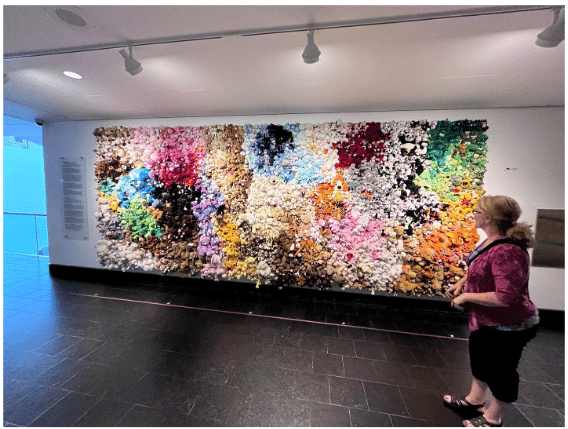
While it’s not exactly a painting (ok, at all), Cormier’s creation really is a dynamic work of art. It does just about everything any colorful non-objective painting does. It certainly “calls your eye” from across the room. On top of that, it lightheartedly raises questions about what constitutes art, why we seek out art, and what we wish to find there, as well as what the function of a public museum should be.
As the artist playfully pointed out: “Hundreds of stuffed animals lovingly stare out at us. In the incredible hustle and bustle that colors our all-too-brief lives, we crazy little creatures all ask ourselves the same eternal questions, the one so dear to Gaugin: ‘Where do we come from? Who are we? Where are we going?’”
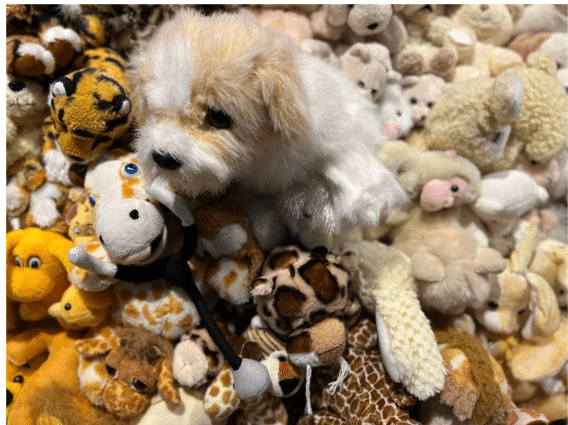
That last bit’s a reference to Paul Gaugin, French post-Impressionist innovator and companion to Vincent van Gogh. Gaugin felt that art, to be honest, should be simple, unrefined, colorful, and decorative (much like Matisse and others that followed who were influenced by him). Gaugin spent the better part of his creative life in Tahiti while it was under French colonial rule, because he wanted “to escape civilization,” as he said. The paintings he made there went deep, probing basic questions of human psychology, nature, and religion, along the way freeing color from being restricted to literal imitation of reality.
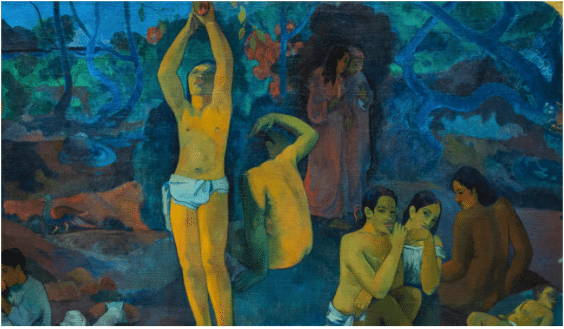
Detail, Paul Gauguin, Where do we come from? What are we? Where are we going?, 1897–98, oil on canvas, 139.1 x 374.6 cm (Museum of Fine Arts, Boston
These days, Gaugin’s legacy is complicated by his having left a wife and five children back in France and acting with indifference to Western social standards while living among the Polynesian islanders.
Cormier, who was born in Quebec, successfully put his experience in scientific agriculture, landscape architecture and design to work in his own firm in Montreal. Working around the world, he carried out many projects whose conceptualization extends well beyond the traditional boundaries of landscape architecture to encompass urban design, public art, and architecture.
Also, stuffed animals.
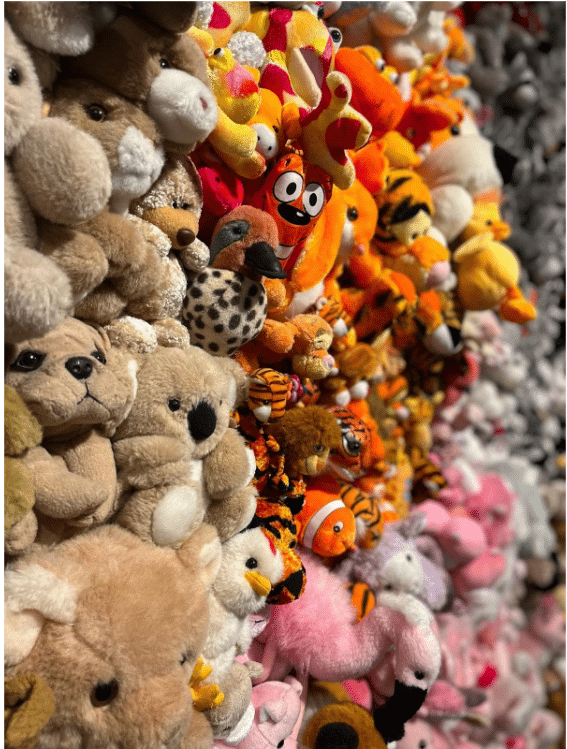
Detail, Stuffed Animals by Claude Cormier. Montreal Musée des beaux-arts.
In all seriousness, Cormier’s Stuffed Animals wouldn’t work nearly as well if the artist hadn’t artfully balanced the play of color along its height and width. If you’re interested in learning more about color and how to use it to improve your art, check out Johnnie Liliedahl’s video, Understanding Color – Modern vs. Old Master.

